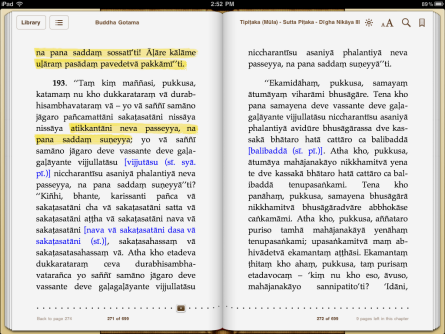
The other day I came across this very true statement: ”It is a sad fact that whereas we rarely find Muslims without the Quran or Christians without the Bible, yet we find many Buddhists without the Nikayas.”
This quote is from an essay by a Ven. Dhammavuddho Bhikkhu which you can read in full here. You should really take your time reading it.
There is not just a “knowlege crisis” in the Buddhist world. This is not because of “too few books printed on Buddhism” – no, quite the contrary is true, maybe because there are “too many books printed on Buddhism”. Let me put it this way: If you are sitting in a raft, and you try to reach the other shore, you probably won’t start reading about the string theory or the special theory of relativity but rather be interested in how the application of Newton’s law of repulsion gets you to the other shore. This is were our training in physics starts and that might also be a smart way to start one’s training in the Dhamma. It resembles the relationship between the most ancient layer of Buddhist teachings which one would expect to be most acquainted with in relationship to whatever came afterwards. Lot of what was developed later is not necessarily wrong and might very well be helpful – but it does not hurt either, if you make yourself well acquainted with the foundation. In the worst case scenario, you may have learnt a few things from the very source of Buddhism, the Buddha, and that won’t be bad or would it?
How many actually know that the Buddha dismissed the idea of instituting a “leader” after his death other than the Dhamma-Vinaya which in no uncertain terms he “appointed” as the teacher of his students after his final Nirvana.[1] Even though Dhamma and Vinaya are very practical in nature, and personally to be realized (paccattaṃ veditabbo) why would it hurt to read what the founder had to say? At least that is what Buddhists did in the first 500 years (you are right, they did not just read, they learned the word of the Buddha by heart)…which lead to the creations of the first mega-universities in the ancient world.
For those looking for an intro into the word of the Buddha have a look at this older post “Where is the Buddhist Bible?” If the above wasn’t enough of a “sales pitch” how about this 😉 :
Besides the strange fact, that hardly any Buddhist knows the word of the Buddha[2] it gets even more worrisome if you look at the status quo in Buddhist countries like Sri Lanka, Thailand or Burma which sometimes seem to mistake carefully selected quotes from the suttas as excuses to backup their medieval structures. No one to blame here except ourselves:
Enlightenment is man’s emergence from his self-imposed immaturity. Immaturity is the inability to use one’s understanding without guidance from another. This immaturity is self-imposed when its cause lies not in lack of understanding, but in lack of resolve and courage to use it without guidance from another. Sapere Aude (dare to know) “Have courage to use your own understanding!”–that is the motto of enlightenment. [link]
Immanual Kant

We could say that for the plain and simple teachings of the Gotama, the samana, the wandering ascetic, the begging monk, the bhikkhu, a very similar understanding lay at the foundation of the deeper enlightenment he had in mind. It included listening carefully to the source of that message – then remembering it – then putting it into practice which lead to the source of this very six-sense-world.[3]
But coming back to the present, the situation in the Western Buddhist post-enlightened ( 🙂 ) hemisphere is strange as well. There are copyrights, by monks, on translations of the Suttas which are sold online. Hmmm… There are countless youtube videos which show alleged quotes of the Buddha which, unfortunately, are from every possible source but not the Tipitaka. And while the ancient word of the Buddha survived 2550 years through famines, wars and other natural and historic disasters and is more accessible than ever in human history to a vast body of interested people – it seems there is less interest in actually listening to the master himself, the source – a practice which was such a fundamental principle for the Western world’s emergence from the “darkness of ignorance”. [4]
Centuries ago, people risked their lives to get a copy of a palm leaf manuscript – journeying from China, through Afghanistan, through India, via Sri Lanka, over Java, back to China – even if it was just a translation of a translation of a translation, they were happy – and we seem to struggle with a proper quote – or at least show some form of respect to the incredible gift former generations have blessed us with. Really astonishing all of this ;-).
When in medieval times a meditation master fainted in joy when he was able to read a translation from a Korean Sutra, which was translated from the Chinese Tipitaka, which was translated from the Sanskrit Tipitaka, which was translated from the Prakrit – and coined a famous ZEN saying – it is our generation, which can pickup a Pali course via the internet in minutes and read the Buddha’s own words within a couple of days – or purchase and compare the same sutta via a multitude of translations and languages to see if our path actually is that ancient path leading to the golden city.
Enough rallying 🙂 Here is the real purpose of this post: To make the Tipitaka even more accessible to our modern times, have a look at the website below which allows you to download a good portion of the Tipitaka in modern epub file format for your sony reader, kindle, iPad, iPhone or other electronic readers.
Reading, memorizing, studying and taking notes can now be done on the journey – if you are willing to exchange weight against battery life 😉
http://books.nibbanam.com/epubs.htm
==Notes===
[1] DN 16, Mahaparinibbana Sutta: “Yo vo Ānanda mayā dhammo ca vinayo ca desito paññatto, so vo mam‘ accayena satthā.” (PTS D. II, 154) “That Dhamma and Vinaya, Ananda, which was taught and pointed out by me to you, that should be the master after my passing.”
[2] A golden standard would be if they at least had the chance to read a fairly managable book like Majjhima Nikaya which gives a very good general idea of what and how the Buddha taught. Even better would be the Samyutta Nikaya, as it has a broader scope, nicely organized and seems to incorporate more of the oldest text strata. A good translation of the Dhammapada would help too 😉
[3] Another look at the stepping stones from listening, over keeping in mind up to enlightenment here in this post: http://theravadin.wordpress.com/2008/08/30/where-is-the-buddhist-bible/
[4] An idea important enough that it cannot be overemphasized: “Sed in primis ad fontes ipsos properandum, id est graecos et antiquos. (Above all, one must hasten to the sources themselves, that is, to the Greeks and ancients.) [link]




2 comments